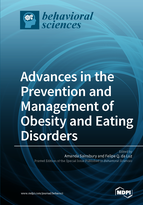Advances in the Prevention and Management of Obesity and Eating Disorders
A special issue of Behavioral Sciences (ISSN 2076-328X).
Deadline for manuscript submissions: closed (31 July 2017) | Viewed by 199179
Special Issue Editors
Interests: obesity; dietary obesity treatments; appetite regulation; eating disorders; body composition
Interests: obesity; eating disorders; clinical psychology; psychotherapy; epidemiology and treatment
Special Issue Information
Dear Colleagues,
Obesity and eating disorders remain major public health concerns worldwide. While we are far from having definitive solutions, scientific understanding of the prevention and mangement of obesity and eating disorders has developed significantly in recent years. This research has been stimulated since the formal recognition in 2013 of binge eating disorder as a psychiatric disorder in the DSM-5 (Diagnostic and Statistical Manual of Mental Disorders, Fifth Edition). Moreover, research into the relationship between obesity and eating disorders has been stimulated by increasing recognition that binge eating can contribute to obesity and vice versa, and that treatments for obesity or binge eating can impact the other condition. In addition, studies on severe and enduring anorexia nervosa and examination of the occurrence of anorexia nervosa among males have been particularly pertinent due to the life-threatening characteristics of anorexia nervosa. Looking towards finding better solutions to these pressing public health concerns, this Special Issue will address the most recent scientific findings regarding the prevention and management of obesity and eating disorders.
A/Prof Amanda Sainsbury
Mr. Felipe Luz
Guest Editors
Manuscript Submission Information
Manuscripts should be submitted online at www.mdpi.com by registering and logging in to this website. Once you are registered, click here to go to the submission form. Manuscripts can be submitted until the deadline. All submissions that pass pre-check are peer-reviewed. Accepted papers will be published continuously in the journal (as soon as accepted) and will be listed together on the special issue website. Research articles, review articles as well as short communications are invited. For planned papers, a title and short abstract (about 100 words) can be sent to the Editorial Office for announcement on this website.
Submitted manuscripts should not have been published previously, nor be under consideration for publication elsewhere (except conference proceedings papers). All manuscripts are thoroughly refereed through a single-blind peer-review process. A guide for authors and other relevant information for submission of manuscripts is available on the Instructions for Authors page. Behavioral Sciences is an international peer-reviewed open access monthly journal published by MDPI.
Please visit the Instructions for Authors page before submitting a manuscript. The Article Processing Charge (APC) for publication in this open access journal is 2200 CHF (Swiss Francs). Submitted papers should be well formatted and use good English. Authors may use MDPI's English editing service prior to publication or during author revisions.
Keywords
- Obesity/overweight
- Feeding and eating disorders
- Prevention and control
- Behavioural therapy
- Disease management
- Health impact assessment
- Treatment
- Therapy
- Diet therapy
- Epidemiology
- Mental health








